Lyons W.C. (ed.). Standard handbook of petroleum and natural gas engineering.2001- Volume 1
Подождите немного. Документ загружается.

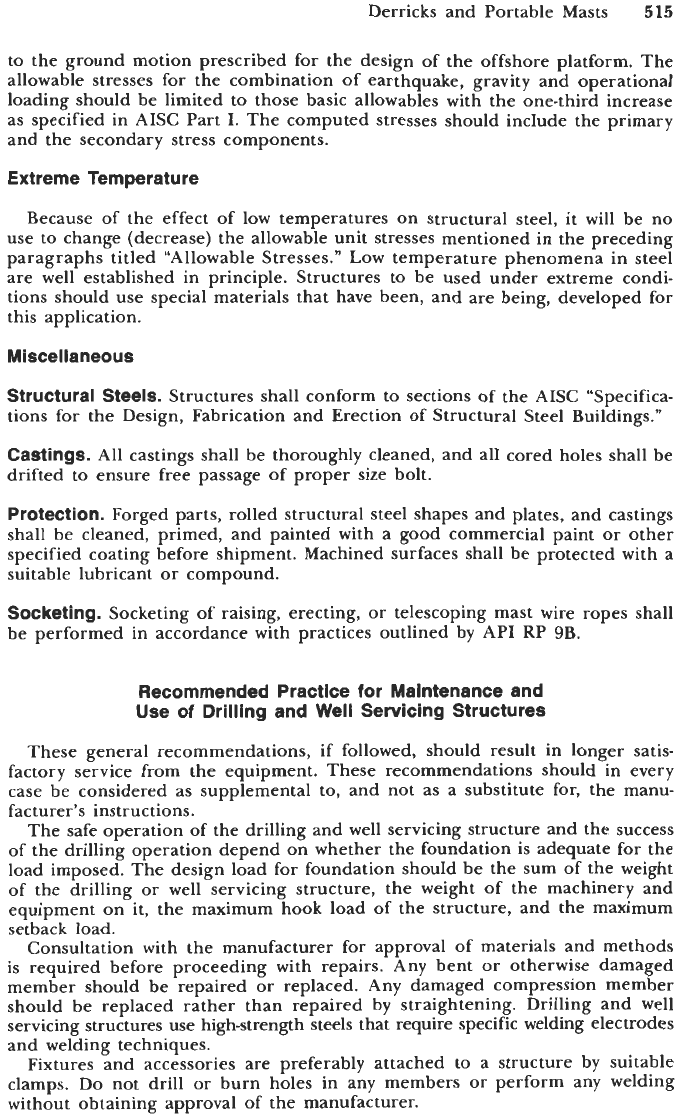
Derricks and Portable Masts
515
to the ground motion prescribed for the design of the offshore platform. The
allowable stresses for the combination
of
earthquake, gravity and operational
loading should be limited to those basic allowables with the one-third increase
as specified in
AISC
Part
I.
The computed stresses should include the primary
and the secondary stress components.
Extreme Temperature
Because of the effect of low temperatures on structural steel, it will be no
use to change (decrease) the allowable unit stresses mentioned in the preceding
paragraphs titled “Allowable Stresses.” Low temperature phenomena in steel
are well established in principle. Structures to be used under extreme condi-
tions should use special materials that have been, and are being, developed for
this application.
Miscellaneous
Structural Steels.
Structures shall conform to sections of the
AISC
“Specifica-
tions for the Design, Fabrication and Erection of Structural Steel Buildings.”
Castings.
All castings shall be thoroughly cleaned, and all cored holes shall be
drifted to ensure free passage of proper size bolt.
Protection.
Forged parts, rolled structural steel shapes and plates, and castings
shall be cleaned, primed, and painted with a good commercial paint or other
specified coating before shipment. Machined surfaces shall be protected with a
suitable lubricant or compound.
Socketing.
Socketing of raising, erecting,
or
telescoping mast wire ropes shall
be performed in accordance with practices outlined by API
RP
9B.
Recommended Practice for Maintenance and
Use
of
Drilling and Well Servicing Structures
These general recommendations, if followed, should result in longer satis-
factory service from the equipment. These recommendations should in every
case be considered as supplemental to, and not as a substitute for, the manu-
facturer’s instructions.
The safe operation
of
the drilling and well servicing structure and the success
of the drilling operation depend on whether the foundation is adequate for the
load imposed. The design load for foundation should be the sum of the weight
of the drilling
or
well servicing structure, the weight of the machinery and
equipment on it, the maximum hook load of the structure, and the maximum
setback load.
Consultation with the manufacturer for approval of materials and methods
is required before proceeding with repairs. Any bent
or
otherwise damaged
member should be repaired
or
replaced. Any damaged compression member
should be replaced rather than repaired by straightening. Drilling and well
servicing structures use high-strength steels that require specific welding electrodes
and welding techniques.
Fixtures and accessories are preferably attached to a structure by suitable
clamps. Do not drill or burn holes in any members
or
perform any welding
without obtaining approval of the manufacturer.
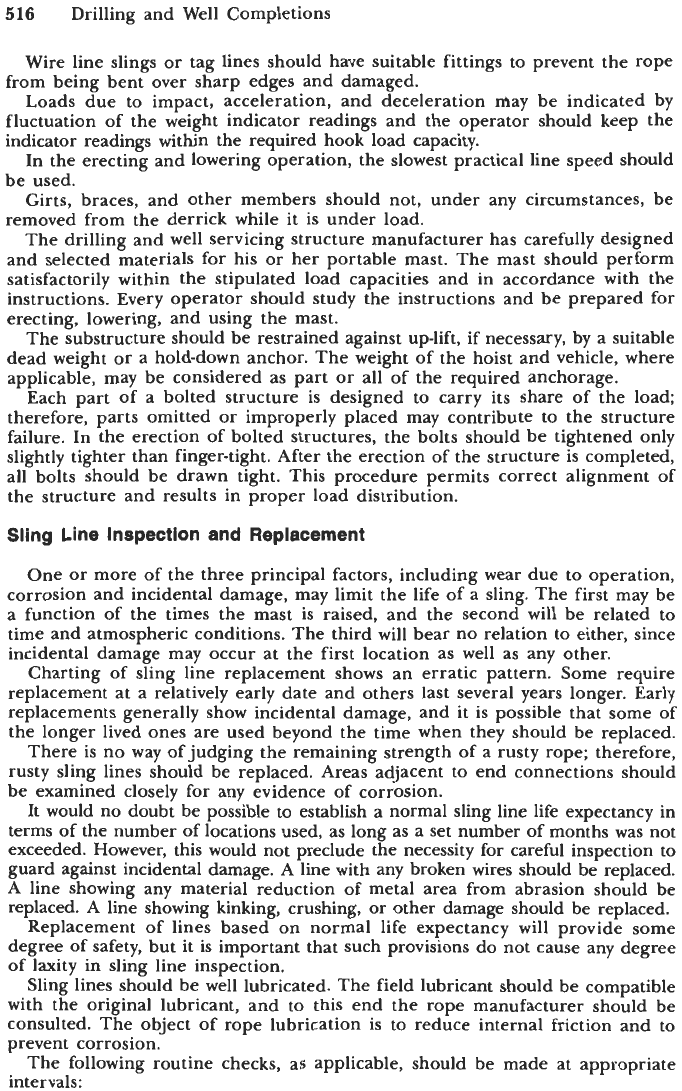
516
Drilling
and
Well Completions
Wire line slings or tag lines should have suitable fittings to prevent the rope
from being bent over sharp edges and damaged.
Loads due to impact, acceleration, and deceleration niay be indicated by
fluctuation of the weight indicator readings and the operator should keep the
indicator readings within the required hook load capacity.
In the erecting and lowering operation, the slowest practical line speed should
be used.
Girts, braces, and other members should not, under any circumstances, be
removed from the derrick while it is under load.
The drilling and well servicing structure manufacturer has carefully designed
and selected materials for his
or
her portable mast. The mast should perform
satisfactorily within the stipulated load capacities and in accordance with the
instructions. Every operator should study the instructions and be prepared for
erecting, lowering, and using the mast.
The substructure should be restrained against uplift, if necessary, by a suitable
dead weight or a hold-down anchor. The weight
of
the hoist and vehicle, where
applicable, may be considered as part or all of the required anchorage.
Each part of a bolted structure is designed to carry its share of the load;
therefore, parts omitted
or
improperly placed may contribute to the structure
failure. In the erection of bolted structures, the bolts should be tightened only
slightly tighter than finger-tight. After
the
erection of the structure is completed,
all bolts should be drawn tight. This procedure permits correct alignment of
the structure
and
results in proper load distribution.
Sling Line inspection and Replacement
One
or
more of the three principal factors, including wear due to operation,
corrosion and incidental damage, may limit the life of a sling. The first may be
a function
of
the times the mast is raised, and the second will be related to
time
and
atmospheric conditions. The third will bear no relation to either, since
incidental damage may occur
at
the first location as well as any other.
Charting of sling line replacement shows an erratic pattern. Some require
replacement at a relatively early date and others last several years longer. Early
replacements generally show incidental damage, and
it
is possible that some of
the longer lived ones are used beyond the time when they should be replaced.
There is no way of judging the remaining strength of a rusty rope; therefore,
rusty sling lines should be replaced. Areas adjacent
to
end connections should
be
examined closely for any evidence of corrosion.
It would no doubt be possible to establish a normal sling line life expectancy in
terms of the number of locations used, as long as a set number
of
months
was
not
exceeded. However, this would not preclude the necessity for careful inspection to
guard against incidental damage. A line with any broken wires should be replaced.
A line showing any material reduction of metal area from abrasion should be
replaced. A line showing kinking, crushing,
or
other damage should be replaced.
Replacement of lines based
on
normal life expectancy will provide some
degree of safety, but it is important that such provisions do not cause any degree
of laxity in sling line inspection.
Sling lines should be well lubricated. The field lubricant should be compatible
with the original lubricant, and
to
this end the rope manufacturer should be
consulted. The object of rope lubrication
is
to reduce internal friction and to
prevent corrosion.
The following routine checks, as applicable, should be made at appropriate
intervals:
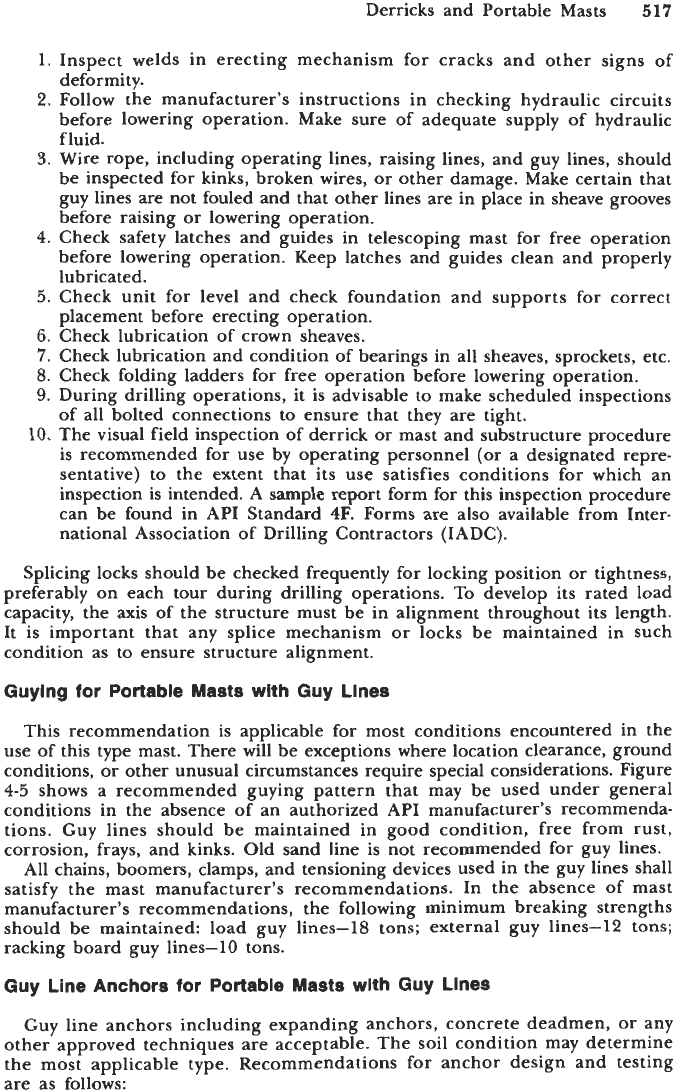
Derricks and Portable Masts
517
1.
Inspect welds in erecting mechanism for cracks and other signs of
deformity.
2.
Follow the manufacturer’s instructions in checking hydraulic circuits
before lowering operation. Make sure of adequate supply of hydraulic
fluid.
3.
Wire rope, including operating lines, raising lines,
and
guy lines, should
be inspected for kinks, broken wires, or other damage. Make certain that
guy lines
are
not fouled
and
that other lines
are
in place in sheave grooves
before raising or lowering operation.
4.
Check safety latches and guides in telescoping mast for free operation
before lowering operation. Keep latches and guides clean and properly
lubricated.
5.
Check unit for level and check foundation and supports for correct
placement before erecting operation.
6.
Check lubrication of crown sheaves.
7.
Check lubrication and condition of bearings in all sheaves, sprockets, etc.
8.
Check folding ladders for free operation before lowering operation.
9.
During drilling operations, it is advisable to make scheduled inspections
of
all bolted connections to ensure that they are tight.
10.
The visual field inspection of derrick or mast and substructure procedure
is recommended for use by operating personnel
(or
a designated repre-
sentative) to the extent that its use satisfies conditions for which an
inspection is intended. A sample report form for this inspection procedure
can be found in API Standard 4F. Forms are also available from Inter-
national Association of Drilling Contractors (IADC).
Splicing locks should be checked frequently for locking position or tightness,
preferably on each tour during drilling operations. To develop its rated load
capacity, the axis of the structure must be in alignment throughout its length.
It is important that any splice mechanism or locks be maintained in such
condition as to ensure structure alignment.
Guying
for
Portable
Masts with
Guy Llnes
This recommendation is applicable for most conditions encountered in the
use of this type mast. There will be exceptions where location clearance, ground
conditions, or other unusual circumstances require special considerations. Figure
4-5
shows
a
recommended guying pattern that may be used under general
conditions in the absence of an authorized
API
manufacturer’s recommenda-
tions. Guy lines should be maintained in good condition, free from rust,
corrosion, frays,
and
kinks. Old sand line is not recommended for guy lines.
All chains, boomers, clamps, and tensioning devices used in the guy lines shall
satisfy the mast manufacturer’s recommendations. In the absence of mast
manufacturer’s recommendations, the following minimum breaking strengths
should be maintained: load guy lines-1
8
tons; external
guy
lines-12 tons;
racking board guy lines-10 tons.
Guy Line Anchors for Portable Masts
with
Guy Lines
Guy line anchors including expanding anchors, concrete deadmen, or any
other approved techniques are acceptable. The soil condition may determine
the most applicable type. Recommendations for anchor design and testing
are as follows:

518
Drilling and Well Completions
A
=
Four crown to ground guys. Minimum guyline size recommended as
5/8"
unless
otherwise specified by mast manufacturer. Tensioning may be judged by catenary
(sag). 6" catenary (approximately 1,000 Ib tension) recommended
on
initial
tensioning.
B
=
Two racking board to board guys. Minimum guyline size recommended
is
9/16"
unless otherwise specified by mast manufacturer. 12"-18" catenary (approximately
500
Ib tension) recommended on initial tensioning.
C
=
Two additional racking board guys to ground. Recommended when winds are in
excess of design magnitude (name plate rating)
or
when pipe set back exceeds
rated racking capacity or when weather protection is used on board. Minimum
guyline size recommended is 9/16" unless otherwise specified by mast manufac-
turer. 6"-12" catenary (approximately 1,000 Ib tension) recommended on initial
tensioning.
D
=
Two or four intermediate mast to ground guys. Recommended at option of mast
manufacturer only. Minimum guyline size recommended
is
5/8"
unless otherwise
specified by mast manufacturer. 6"-12" catenary (approximately 1,000 Ib tension)
recommended on initial tensioning.
CAUTION: WHEN THE TWO
"A
LINES ON THE DRAWWORKS
SIDE
OF
THE MAST
ARE
USED
AS
LOAD GUYS, THE MINIMUM LINE
SIZE
SHALL BE
3/4"
IPS 6
x
31
CLASS
OR
BETTER, AND THE
"2"
DIMENSION SHALL NOT
BE
LESS THAN
60'.
Figure
4-5.
Recommended guying pattern-general conditions
[3].
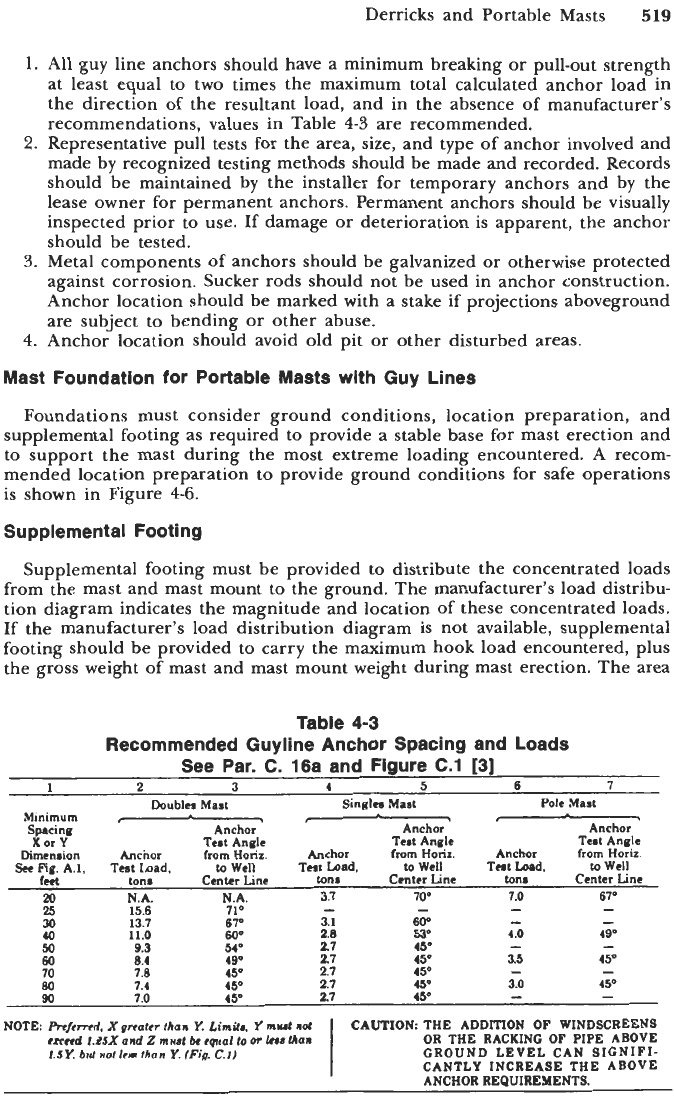
Derricks and Portable Masts
519
NOTE:
Prefemd.
X
pnater
than
Y.
Limita,
Y
nawt
not
emeed
I.2SXand
Z
mmt
be
eplial
to
bz
leas
than
1.SX
bid
notlrm
than
Y.
(Fig.
C.1)
All
guy line anchors should have a minimum breaking or pull-out strength
at least equal to two times the maximum total calculated anchor load in
the direction of the resultant load, and in the absence of manufacturer's
recommendations, values in Table
4-3
are recommended.
Representative pull tests for
the
area, size, and type of anchor involved and
made by recognized testing methods should be made and recorded. Records
should be maintained by the installer for temporary anchors and by the
lease owner for permanent anchors. Permanent anchors should be visually
inspected prior to use. If damage or deterioration is apparent, the anchor
should be tested.
Metal components of anchors should be galvanized or otherwise protected
against corrosion. Sucker rods should not be used in anchor construction.
Anchor location should be marked with a stake if projections aboveground
are subject to bending or other abuse.
Anchor location should avoid old pit or other disturbed areas.
CAUTION
THE ADDITION
OP
WINDSCREENS
OR THE RACKING
OF
PIPE
ABOVE
GROUND LEVEL
CAN
SICNIFI-
CANTLY INCREASE THE ABOVE
Mast Foundation for Portable Masts with Guy Lines
Foundations must consider ground conditions, location preparation, and
supplemental footing as required to provide a stable base for mast erection and
to support the mast during the most extreme loading encountered.
A
recom-
mended location preparation to provide ground conditions for safe operations
is shown in Figure
4-6.
Supplemental Footing
Supplemental footing must be provided to distribute the concentrated loads
from the mast and mast mount to the ground. The manufacturer's load distribu-
tion diagram indicates the magnitude and location of these concentrated loads.
If the manufacturer's load distribution diagram is not available, supplemental
footing should be provided to carry the maximum hook load encountered, plus
the gross weight
of
mast and mast mount weight during mast erection. The area
Table
4-3
Recommended Guyline Anchor Spacing and Loads
See Par. C. 16a and Figure C.l
[3]
1
2
3
4
5
6
7
Doublca
Mast Singles
Mast
Pole
Mast
Mini
m
u
m
.
Spacing Anchor Anchor Anchor
X
or
Y
Test
Angle
Test
Angle Test Angle
Dimeniion Anchor
from
Horir.
Anchor
from
Horiz.
Anchor from
Horir.
See
Fig.
A.1. Test
had,
to
Well Test
Load,
to
Well
Test
Load,
to
Well
Center Line
feet
ton8 Center Line tons Center Line
tons
7.0 67'
N.A.
N.A.
3.7
70'
20
25
15.6 71'
30
13.7 67O 3.1 609
-
-
40
11.0
600
2.8
530
4.0 49'
50
9.3
540
27
45.
- -
45-
60
8.4
499
2.7
45-
35
70 7.8
450
2.7
450
-
7.4
45'
2.7
450
3.0
450
80
w
7.0
450
2.7
4
50
-
-
-
-
-
-
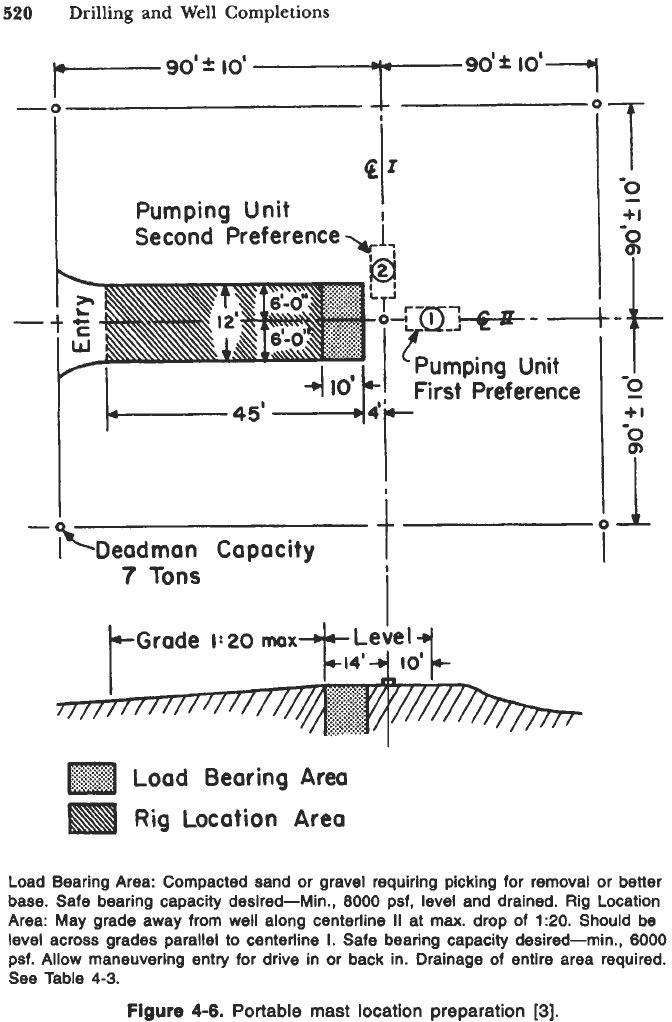
540
Drilling
and
Well
Completions
-0
-
+I
Second Preference
+I
'1
t
T
I
-%Deadman Capacity
7
Tons
Grade
1:20
max
............
Load Bearing Area: Compacted sand or gravel requiring picking for removal or better
base. Safe bearing capacity desired-Min.,
8000
psf, level and drained. Rig Location
Area: May grade away from
well
along centerline
II
at ma. drop of
1:20.
Should
be
level across grades parallel
to
centerline
1.
Safe bearing capacity desired-min.,
6000
psf. Allow maneuvering entry for drive in or back in. Drainage of entire area required.
See
Table
4-3.
Figure
4-6.
Portable mast
location
preparation
131.

Derricks and Portable Masts
541
and type of supplemental footing must ensure that the safe bearing capacity of
soils
on
location is not exceeded.
Precautions and Procedures tor Low-Temperature Operations
A survey of
13
drilling contractors operating
193
drilling rigs in northern
Canada and Alaska indicated that there is a wide range of experience and
operating practices under extremely low-temperature conditions. A sizable
number of portable masts failed in the lowering
or
raising process in winter.
Thus the exposure to low-temperature failures focuses on mast lowering and
raising operations. Based on reports, however, this operation has been
accomplished successfully in temperatures as low as
-50°F.
While the risk may
be considerably greater because of the change in physical characteristics of steel
at low temperatures, operators may carry on “normal” operations even at
extremely low temperatures. This may be accomplished by closely controlled
inspection procedures and careful handling and operation to reduce damage and
impact loading during raising and lowering operations. At present, there seems
to be no widely accepted or soundly supported basis for establishing a critical
temperature
for
limiting the use of these oilfield structures. Experience in the
operation of trucks and other heavy equipment exposed to impact forces
indicates that
-40°F
may be the threshold
of
the temperature range, at which
the
risk
of structural failure may increase rapidly. Precautionary measures should
be more rigidly practiced at this point. The following recommended practices
are included
for
reference:
1. To the extent possible, raising and lowering the mast at the “warmest” time
of the day; use any sunlight
or
predictable atmospheric conditions.
Con-
sider the wind velocity factors.
2.
Use any practical, available means, such as high-pressure steam timber
bonfires, to warm sections of the mast.
3.
Take up and loosen mast raising lines several times
to
assure the free
movement of all parts.
4.
Warm up engines and check the proper functioning of all machinery
to
assure that there will be no malfunctions that would result in sudden
braking or jarring of the mast. Mast travel, once begun, must be slow,
smooth, and continuous.
5.
Inspection and repair provided in the section titled “Recommended
Practice for Maintenance and Use of Drilling and Well Servicing Structures”
are extremely critical under low-temperature conditions. Masts should be
maintained in excellent condition.
6.
In making field welds, the temperature of structural members should
preferably be above
O’F.
In the weld areas, steel should be preheated before
welding
or
cutting operations.
Derrick Efficiency Factor
Derrick efficiency factor
(DEF)
is often used to rate
or
classify derrick
or
mast structural capacity
[1,7,8].
The derrick efficiency factor is defined as a
ratio of actual load to an equivalent load that is four times the force in the
derrick leg carrying the greatest load. Thus the ratio
is
Actual load
Equivalent load
DEF =
(4-7)
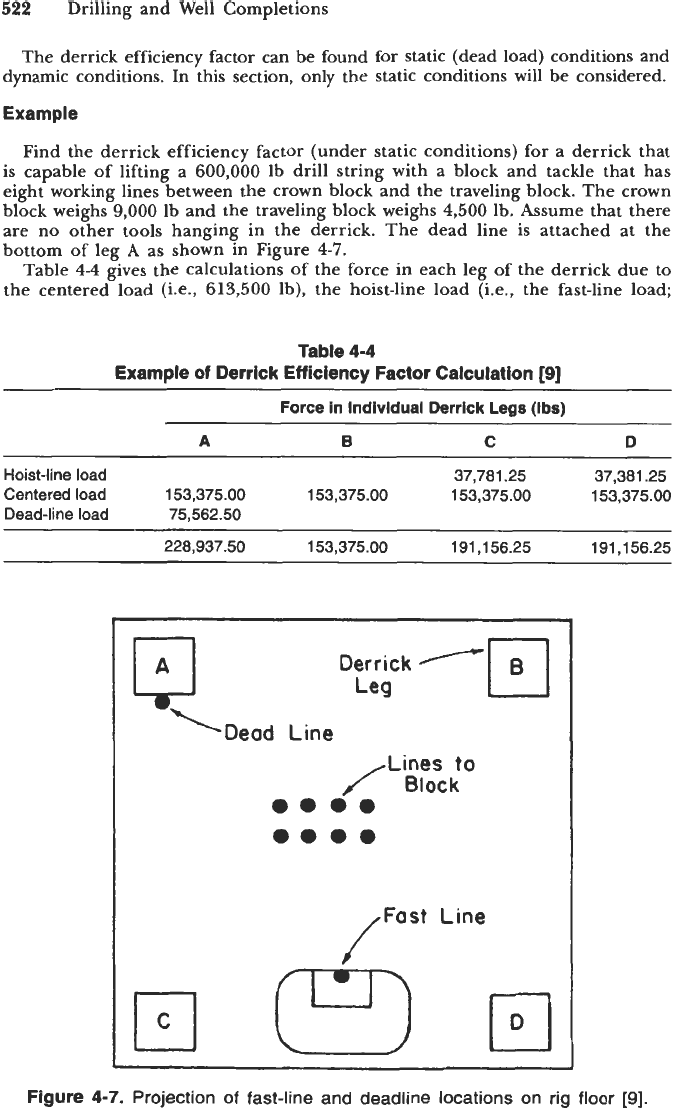
522
Drilling and Well Completions
The derrick efficiency factor can be found for static (dead load) conditions and
dynamic conditions. In this section, only the static conditions will be considered.
Example
Find the derrick efficiency factor (under static conditions) for a derrick that
is capable of lifting a
600,000
lb drill string with a block and tackle that has
eight working lines between the crown block and the traveling block. The crown
block weighs
9,000
lb and the traveling block weighs
4,500
lb. Assume that there
are no other tools hanging in the derrick. The dead line is attached at the
bottom
of
leg
A
as shown in Figure
4-7.
Table
4-4
gives the calculations of the force in each leg of the derrick due to
the centered
load
(Le.,
613,500
lb), the hoist-line load (i.e., the fast-line load;
Table
4-4
Example
of
Derrick Efficiency Factor Calculation
[9]
Force in Individual Derrick
Legs
(Ibs)
A
B C
D
Hoist-line load
37,781 25 37,381 25
Centered load
153,375.00 153,375.00 153,375.00 153,375.00
Dead-line load
75,562.50
228,937.50 153,375.00 191,156.25 191,156.25
Figure
4-7.
Projection of fast-line and deadline locations on rig
floor
[9].
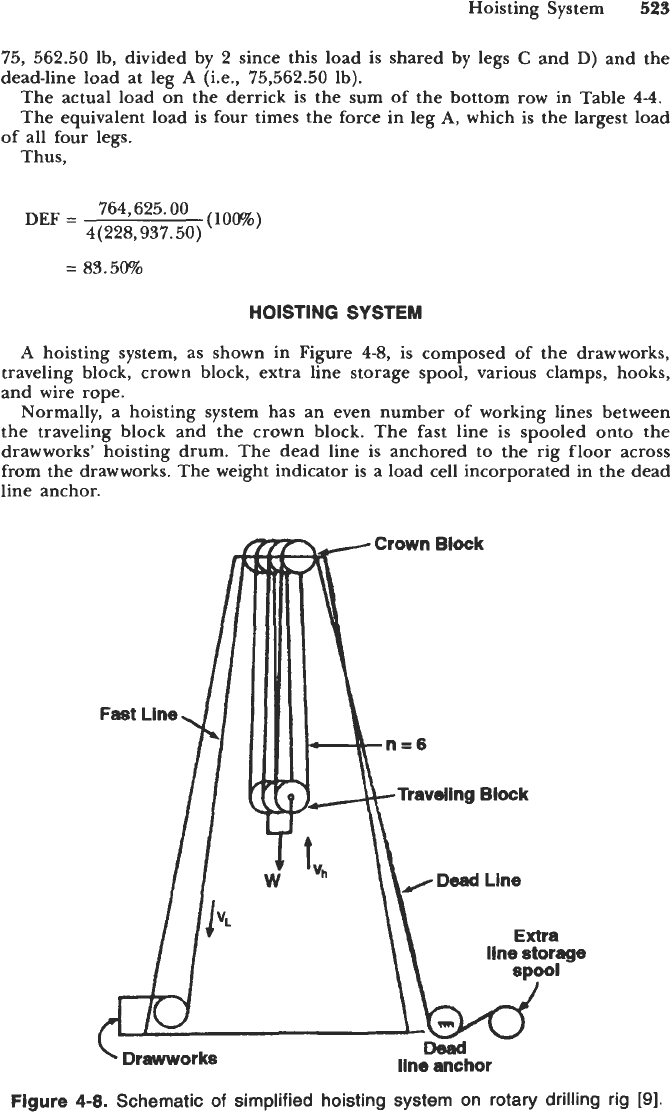
Hoisting System
543
75, 562.50
lb, divided by
2
since this load is shared by legs
C
and
D)
and the
dead-line load at leg
A
(i.e.,
75,562.50
lb).
The actual load on the derrick is the sum of the bottom row in Table
4-4.
The equivalent load is four times the force
in
leg
A,
which is the largest load
Thus,
of all four legs.
764,625.00
4(
228,937.50)
DEF
=
=
83.50%
HOISTING
SYSTEM
A
hoisting system, as shown in Figure
4-8,
is composed
of
the drawworks,
traveling block, crown block, extra line storage spool, various clamps, hooks,
and wire rope.
Normally, a hoisting system has an even number of working lines between
the traveling block and the crown block. The fast line is spooled onto the
drawworks’ hoisting drum. The
dead
line is anchored
to
the rig floor across
from the drawworks. The weight indicator is
a
load cell incorporated in the dead
line anchor.
Dead
line
anchor
Figure
4-8.
Schematic
of
simplified hoisting system on rotary drilling rig
[9].
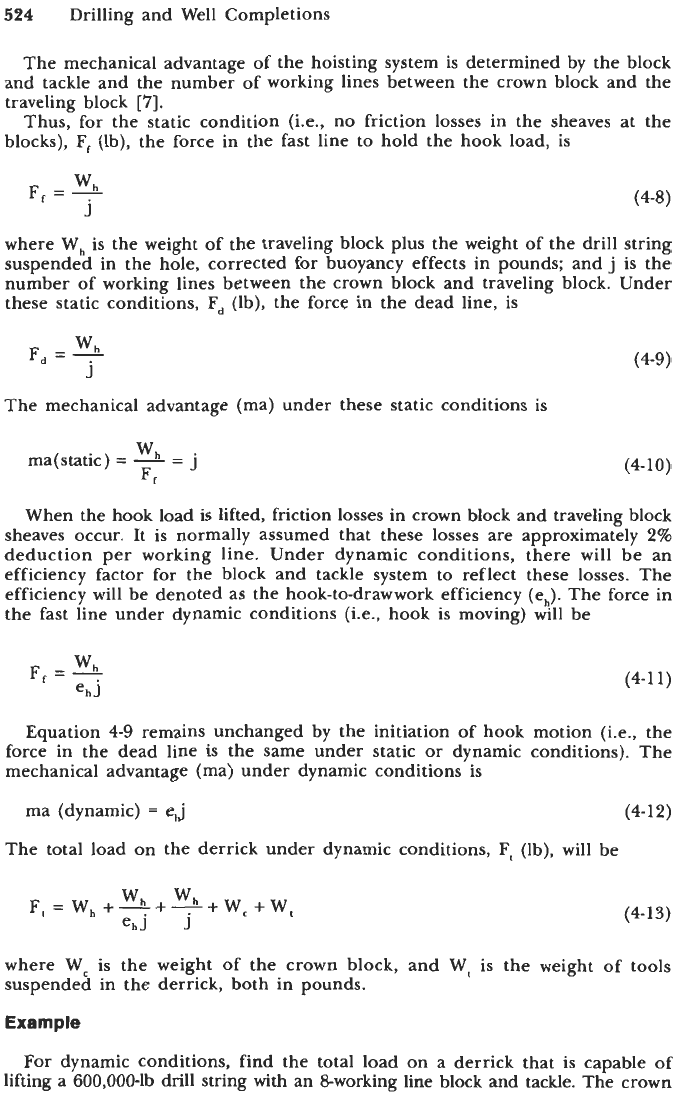
524
Drilling and Well Completions
The mechanical advantage of the hoisting system is determined by the block
and tackle and the number of working lines between the crown block and the
traveling block
[7].
Thus, for the static condition (i.e., no friction losses in the sheaves at the
blocks),
F,
(lb), the force in the fast line to hold the hook load, is
Wh
F,
=
-
J
(4-8)
where Wh is the weight of the traveling block plus the weight of the drill string
suspended in the hole, corrected for buoyancy effects in pounds;
and
j
is the
number of working lines between the crown block and traveling block. Under
these static conditions,
F,
(lb), the force in the dead line, is
The mechanical advantage (ma) under these static conditions is
ma(static)
=
-
wh
-j
-
F,
(4-10)
When the hook load is lifted, friction losses in crown block and traveling block
sheaves occur. It is normally assumed that these losses are approximately
2%
deduction per working line. Under dynamic conditions, there will be an
efficiency factor for the block and tackle system to reflect these losses. The
efficiency will be denoted
as
the hook-to-drawwork efficiency (eh). The force in
the fast line under dynamic conditions (i.e., hook is moving) will be
wh
F,
=
-
ehJ
(4-11)
Equation
4-9
remains unchanged by the initiation of hook motion (i.e,, the
force in the dead line is the same under static or dynamic conditions). The
mechanical advantage (ma) under dynamic conditions is
ma (dynamic)
=
e$
(4-12)
The total load on the derrick under dynamic conditions,
F,
(lb), will be
F,
=
Wh
+-+e+
wh
W,
+
W,
ehj
J
(4-13)
where
Wc
is
the weight of the crown block, and
Wt
is the weight of tools
suspended in the derrick, both in pounds.
Example
For dynamic conditions, find the total load on a derrick that is capable of
lifting a 600,000-lb drill string with an &working line block and tackle. The crown
